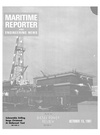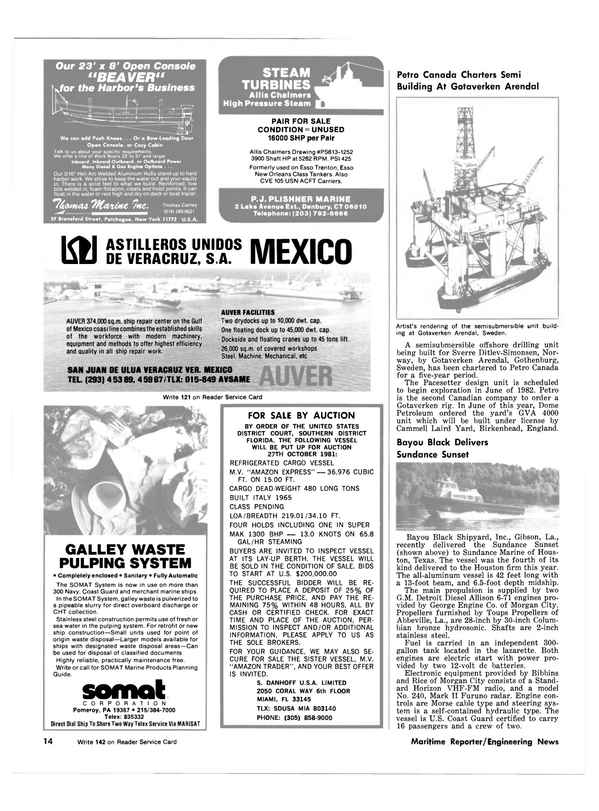
Moss Rosenberg Delivers First Of Three Chemical/Gas Carriers For Norwegian Owners
The Igloo Finn, an 11,200-dwt gas and chemical carrier was delivered recently by Moss Rosenberg Verft, a.s. to Partrederiet NEMO, Oslo, Norway. It is the first in a series of three and will be operated by A / S Havtor Management, Oslo.
The Igloo Finn (shown above) is a highly sophisticated multipurpose carrier designed to transport up to eight different cargoes simultaneously. The ship is a diesel driven, single-deck vessel with forecastle and poop. She carries six free-standing, cylindrical, stainless-steel cargo tanks suitable f o r carrying gases as well as chemicals. In addition, two built-in wing tanks coated for chemicals only are arranged in the foreship. A deckhouse for a refrigeration plant is located midship.
The ship was classed by Det norske Veritas, class 4- 1A1, EO, Ice 1A — "Tanker for Liquefied Gas" and "Tanker for Chemicals." The ship is also built in accordance with U.S. Coast Guard "Rules and Regulations for Foreign Flag Vessels," the IMCO Codes for gas and chemical carriers, as well as Finnish Ice Class 1A according to the Finnish- Swedish Ice Class Rules of 1971.
The main engine is a six-cylinder, slow-speed, turbocharged Sulzer diesel type 6 RLA 56. It has maximum output of approximately 7,590 bhp at 155 rpm and is directly coupled to a four-blade highly skewed nickel-aluminumbronze controllable-pitch propeller.
Trial speed is approximately 16 knots with propane loaded draft of 7 meters (about 23 feet) and 100 percent output.
The Igloo Finn has a "stainless" capacity of 8,300 cubic meters at 20 degrees C consisting of six pressure vessels all insulated with polyurethane. One tank is installed longitudinally in the forward hold and the others are installed transversely in the remaining holds. The tanks are designed to transport cargoes at minimum minus 104 degrees C and maximum plus 80 degrees C.
Design criteria also include maximum specific weight of cargo 1.8 tons/m3 and maximum tank pressure of 3.95 bar. Each tank is equipped with a separate loading/ discharge line. The ship also is equipped with two coated, builtin tanks with a total of 600 cubic meters capacity. These are scantied for cargoes of specific gravity up to 1.0 tons/m3.
The ship has a highly sophisticated cargo handling system, enabling the vessel to transport eight different cargoes simultaneously of which two are fully refrigerated. A r e f r i g e r a t i on plant is located in a deckhouse midship and consists of three identical R22 cascade units. Two units each service three cargo tanks, while the third is a spare.
Two refrigeration units have capacity to maintain a cargo of ethylene at atmospheric pressure when the air and seawater temperatures indicate plus 45 degrees C and plus 32 degrees C, respectively.
The ship is also equipped with indirect cooling and heating systems with capacity to maintain cargo temperature at minimum minus 30 degrees C and maximum plus 80 degrees C. The cargo is heated/cooled by circulating ethanol through coils welded to the exterior of the tank shells.
Loading can be accomplished from both over-pressure and atmospheric tanks in about 15 hours based on refrigerated tanks and gas return to shore. Each tank is equipped with a deepwell pump with 185 m3/hr capacity for discharging. When discharging against high back-pressure, two booster pumps with 280 m3/ hr capacity each can be connected in series. During discharge, the cargo may be heated in a seawater heat exchanger. All tanks, which can be loaded and discharged i n d e p e n d e n t l y , are equipped with a tank cleaning system.
The ship is designed to transport ethyelene, ethane, propylene, propane, butadiene, ammo- nia, MAPP gasses, VCM, butane, butane/propane mixtures, propylene oxide, C4-stream, and butylene.
The Igloo Finn is equipped with two radar sets with anticollision devices, gyro equipment, echosounder, satellite navigator, etc.
A gas-detection system and a 900 Nm3/hr combined inert gas generator/incinerator have been installed. Both are designed and manufactured by Moss Verft.
Read Moss Rosenberg Delivers First Of Three Chemical/Gas Carriers For Norwegian Owners in Pdf, Flash or Html5 edition of October 15, 1981 Maritime Reporter
Other stories from October 15, 1981 issue
Content
- INMARSAT Set For February 1 Start page: 6
- Launch First Five-Screw Crewboat At Gulf Craft; Diesel Plant Modified By George Engine page: 7
- Submersible Drilling Barge "The Mr. Ray' Christened At McDermott Yard page: 8
- Tidewater Elects Bankston President, Koock, Ramey Are New VPs page: 8
- Crowley Establishes Unit For Energy Transportation Headed By VP Kirkeide page: 9
- Mrs. Joseph Elected Director At Twin City Barge page: 10
- Megasystems Cargo Control Systems Ordered For Product Carriers page: 10
- Dravo SteelShip Delivers The 'Mobilian' For Warrior And Gulf Navigation Company page: 11
- Moss Rosenberg Delivers First Of Three Chemical/Gas Carriers For Norwegian Owners page: 12
- Progressive Delivers First Boat For Africa page: 12
- Bay Shipbuilding Names John Schermond New Manager Of Contracts page: 13
- Zapata Christens Three Offshore Drilling Rigs Built In Singapore page: 13
- Bayou Black Delivers Sundance Sunset page: 14
- Two Brochures Available On Sperry's Doppler Speed, Navigation Systems page: 16
- SNAME Requests Technical Papers For 1982 Annual page: 16
- Five Executive Promotions Announced At Perko page: 16
- McAllister Names Alban Division Manager page: 17
- Research Continues For More Fuel Efficiency With Lower Grade Fuels page: 18
- Halter To Build Two Supply Vessels For Jackson Marine page: 51
- Canadian Firm Orders Four Large Bulk Carriers page: 52
- Seaward International Awarded Fourth Fendeir Contract By U.S. Navy page: 52
- Ashland Oil Will Use Megasystems D.O.T. Unit To Evaluate Additives page: 52
- IHI To Build World's First Mobile Arctic Caisson Rig For Beaufort Sea page: 55
- George Engine Reports Record Growth-Sales —Brochure Available page: 56
- DOT Approves License For Deepwater Oil Port Offshore Texas page: 57
- $3-Million Navy Contract Awarded To Tracor page: 57
- Christen Navy Hydrofoil 'Aquila' —Third Of Six Missile Ships Building At Boeing Marine page: 58
- HUDSHIP To Build Four Tug/Supply Vessels For Hornbeck page: 58
- 4,000-Ton Drydock 'H.S. Geneen' Ch ristened At Delta Shipyard page: 58
- Levingston Delivers Dixilyn-Field 87 page: 58
- Approve $16-Million MarAd Title XI Guarantee For Coal-Carrying Barge page: 75
- Megasystems Combustion Analysis Systems Ordered By Phillips page: 76
- $35.8-Million Contract Awarded To Build New Lock On Gulf Waterway page: 76


